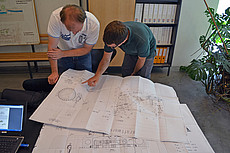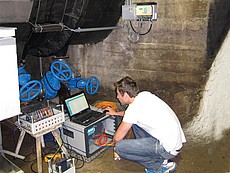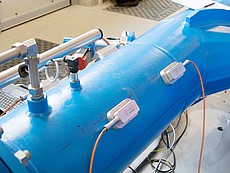Acoustic flow measurements
By means of the acoustic distance-time difference procedure and clamp-on sensors the flow in power plants and other industrial plants can be determined with little effort during normal operation and without any intrusion into existing pipelines.
Fields of application
The determination of the flow and thus conclusions regarding the efficiency are an essential part during the analysis and optimisation process of existing hydropower plants / power plants and industrial plants in general. Furthermore, plant profitability (RoI - Return on Investment) can be determined based on the values measured.
- Control of warranted values by means of acceptance/approval measurements
- Verifications before and after comprehensive revision and repair works
- Inventory of the current situation in order to set out optimisation potential, e.g. energy savings potential or possible downsizing of plant elements without any impact on safety and productivity
- Trouble shooting in the event of oscillations, noise etc.
Measurement standards applied
All our measurements are based on the internationally acknowledged IEC and ISO standards. Depending on clients’ requirements our measurements are realised according to the following standards: IEC 60041 "Field acceptance tests to determine the hydraulic performance of hydraulic turbines, storage pumps and pump-turbines"
- IEC 62006 "Hydraulic machines – Acceptance tests of small hydroelectric installations"
- IEC 60534: Industrial-process control valves
- ISO 9906: Rotodynamic pumps – Hydraulic performance acceptance tests
Advantages of acoustic flow measurements
There is no impact on existing pipelines as clamp-on sensors are applied. Also, measurement equipment can be installed and measurements can be realised during normal operation.
- Virtually total independence of the Reynolds number and thus the same measurement accuracy with laminar as well as with turbulent flow profiles
- Non-sensitive against pressure shocks, water hammer or vibrations
- Non-invasive, no parts moved, non-wearing
Disadvantages of acoustic flow measurements
- Compressibility and/or extremely high viscosity of the media to be measured cushion ultrasonic propagation (acoustic waves) and thus may lead to measurement errors.
- Pipelines have to be made of acoustically conductive material
- Non-homogenous, highly viscous fluids as well as fluids bearing solid matters cannot be measured or only to a very limited extent
- Measurements limited to pipeline diameters of ~5m max.
References: efficiency measurements
Publications and additional information
Download
General information:
Institute of Hydraulic Fluid Machinery (HFM)







